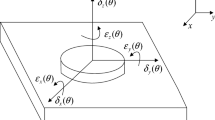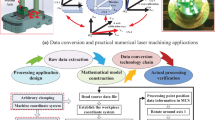Abstract
In this paper, a geometric error modeling method is carried out on six-axis motion platform (SMP) in laser welding system (LWS), and an optimized algorithm is proposed for the alignment in LWS based on the error model. First, the topological structure of the given SMP is analyzed, and related homogeneous transformation matrices which are used for standing the orientation of SMP are established. By these matrices, the geometric error model is developed mathematically. Then, the error model is used for predicting the alignment deviations. A corresponding series of experiments for calculating the optical power loss in alignment are employed, and the comparison between simulation and experiments results indicate the validation of the error model. Furthermore, an optimized algorithm is applied to search the optimum aligning trajectory. Compared to conventional method, this algorithm has a broader range in searching extreme value, which can reduce the computational volume and improve the efficiency. It is also beneficial for improving the success rate of escaping from the local minimum spot and finding the optimum alignment spot. The error model is helpful to analyze the error propagation process and improve the alignment efficiency in LWS, which can be applied to other similar multi-axis precise system.












Similar content being viewed by others
Abbreviations
- SMP:
-
Six-axis motion platform
- MMS:
-
Multi-axis motion system
- MMP:
-
Multi-axis motion platform
- OD:
-
Optical device
- LWS:
-
Laser welding system
- B :
-
Typical body
- X, Y, Z, U, V, W :
-
Axis in MMS
- x, y, z, α, γ, β :
-
Geometric error
- T :
-
Intersubject transformation matrix
- E :
-
Error matrix of homogeneous transformation
- T s :
-
Intersubject coordinate offset matrix
- E s :
-
Motion transformation matrix
- T s k :
-
Kinematic error matrix
- E s k :
-
Static error matrix
- LD:
-
Laser diode
- SMF:
-
Single-mode optical fiber
- PL:
-
Power loss
- EMM:
-
Error modeling method
- EMSM:
-
Error modeling searching method
References
Yang, H. M., Chen, C. T., Ro, R., et al. (2010). Investigation of the efficient coupling between a highly elliptical Gaussian profile output from a laser diode and a single mode fiber using a hyperbolic-shaped microlens. Optics & Laser Technology, 42(6), 918–926.
Jedrzejczyk, D., Asbahr, P., Pulka, M., et al. (2014). High-power single-mode fiber coupling of a laterally tapered single-frequency diode laser. IEEE Photonics Technology Letters, 26(8), 845–847.
Zheng, Y., Li, B., & Duan, J. (2015). Automatic waveguide-fiber alignment algorithm based on polynomial fitting. In 2015 international conference on photonics, optics and laser technology (PHOTOPTICS) (pp. 77–80).
Koganti, P. B., & Udwadia, F. E. (2017). Dynamics and precision control of uncertain tumbling multibody systems. Journal of Guidance, Control and Dynamics, 40(5), 1176–1190.
Tang, H., Duan, J. A., Lan, S., et al. (2015). A new geometric error modeling approach for multi-axis system based on stream of variation theory. International Journal of Machine Tools and Manufacture, 92, 41–51.
Chen, G., Li, T., Chu, M., et al. (2014). Review on kinematics calibration technology of serial robots. International Journal of Precision Engineering & Manufacturing, 15(8), 1759–1774.
Kim, C. K., Lai, M. C., Zhang, Z. C., et al. (2017). Modeling and numerical simulation of afterburning of thermobaric explosives in a closed chamber. International Journal of Precision Engineering & Manufacturing, 18, 979.
Liu, T., Qian, L., Xu, Y., et al. (2016). Kinematic error modeling and analysis of the loading device based on multi-body theory and stream of variation theory. In 2016 IEEE international conference on information and automation (ICIA), IEEE.
Andolfatto, L., Lavernhe, S., & Mayer, J. R. R. (2011). Evaluation of servo, geometric and dynamic error sources on five-axis high-speed machine tool. International Journal of Machine Tools and Manufacture, 51(10–11), 787–796.
Li, X., Zhao, H., Zhao, X., et al. (2017). Contouring compensation control based on high accuracy contour error estimation for multi-axis motion systems. International Journal of Advanced Manufacturing Technology, 93, 1–11.
Tang, H., Duan, J. A., & Lu, S. (2017). Stream-of-variation (SOV) theory applied in geometric error modeling for six-axis motion platform. IEEE Transactions on Systems Man & Cybernetics Systems, 99, 1–9.
Ibaraki, S., Goto, S., Tsuboi, K., et al. (2018). Kinematic modeling and error sensitivity analysis for on-machine five-axis laser scanning measurement under machine geometric errors and workpiece setup errors. The International Journal of Advanced Manufacturing Technology, 96, 4051–4062.
Creamer, J., Sammons, P. M., Bristow, D. A., et al. (2017). Table-based volumetric error compensation of large five-axis machine tools. Journal of Manufacturing Science and Engineering. https://doi.org/10.1115/1.4034399.
Zhao, D., Bi, Y., & Ke, Y. (2017). An efficient error compensation method for coordinated CNC five-axis machine tools. International Journal of Machine Tools and Manufacture, 123, 105–115.
Xin, L. (2010). Kinematic error modeling for tailored blank laser welding machine based on the improved MBS. Journal of Mechanical Engineering, 46(2), 61.
Chen, J. X., Lin, S. W., & Zhou, X. L. (2016). A comprehensive error analysis method for the geometric error of multi-axis machine tool. International Journal of Machine Tools and Manufacture, 106, 56–66.
Cheng, Q., Zhao, H., Zhang, G., et al. (2014). An analytical approach for crucial geometric errors identification of multi-axis machine tool based on global sensitivity analysis. The International Journal of Advanced Manufacturing Technology, 75, 107–121.
Lee, R. S. (2012). Applying bidirectional kinematics to assembly error analysis for five-axis machine tools with general orthogonal configuration. The International Journal of Advanced Manufacturing Technology, 62(9–12), 1261–1272.
Chun, J., Wu, Y., Dai, Y., et al. (2005). Study on automatic alignment technique in fiber active devices packaging. China Mechanical Engineering, 16(24), 2163–2167.
Zhao, J. L., Liu, Y., Guo, Z., et al. (2015). Error analysis on CNC gear hobbing machine spindle transmission chain based on SOV theory. International conference on advanced engineering materials and technology,. https://doi.org/10.2991/icaemt-15.2015.42.
Jee, S. (2012). Real-time inertia compensation for multi-axis CNC machine tools. International Journal of Precision Engineering & Manufacturing, 13(9), 1655–1659.
Qazani, M. R. C., Pedrammehr, S., & Nategh, M. J. (2018). An investigation on the motion error of machine tools’ hexapod table. International Journal of Precision Engineering & Manufacturing, 19(4), 463–471.
Aguado, S., Samper, D., Santolaria, J., et al. (2012). Towards an effective identification strategy in volumetric error compensation of machine tools. Measurement Science & Technology, 23(6), 065003.
Zhang, E. Z., Zhao, J., Ji, S. J., et al. (2015). Comprehensive error modeling and compensation for precision polishing platform based on orthogonal experiment and interpolation algorithm. Guangxue Jingmi Gongcheng/Optic and Precision Engineering, 23(12), 3422–3429.
Kilikevičius, A., & Kasparaitis, A. (2017). Dynamic research of multi-body mechanical systems of angle measurement. International Journal of Precision Engineering & Manufacturing, 18(8), 1065–1073.
Zeng, W., & Rao, Y. (2019). Modeling of assembly deviation with considering the actual working conditions. International Journal of Precision Engineering & Manufacturing, 20(5), 791–803.
Du, S., Yao, X., Huang, D., et al. (2015). Three-dimensional variation propagation modeling for multistage turning process of rotary workpieces. Computers & Industrial Engineering, 82, 41–53.
Suruga Seiki Corporation. Suruga Fiber Alignment Information: Alignment System. http://eng.surugaseiki.com/alignment.
Acknowledgements
This research is supported by the Natural Science Foundation of China (Grant No. 51705149), and the Natural Science Foundation of Hunan Province, China (Grant No. 2018JJ3168).
Author information
Authors and Affiliations
Corresponding author
Additional information
Publisher's Note
Springer Nature remains neutral with regard to jurisdictional claims in published maps and institutional affiliations.
Rights and permissions
About this article
Cite this article
Tang, H., Zhang, Z., Li, C. et al. A Geometric Error Modeling Method and Trajectory Optimization Applied in Laser Welding System. Int. J. Precis. Eng. Manuf. 20, 1423–1433 (2019). https://doi.org/10.1007/s12541-019-00151-8
Received:
Revised:
Accepted:
Published:
Issue Date:
DOI: https://doi.org/10.1007/s12541-019-00151-8




